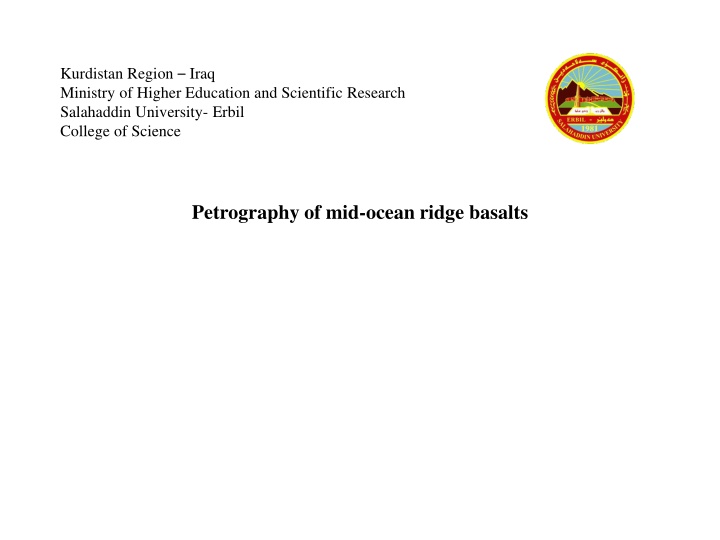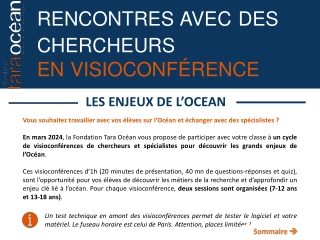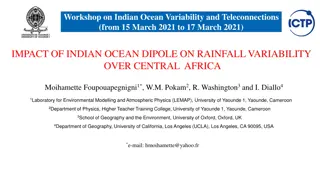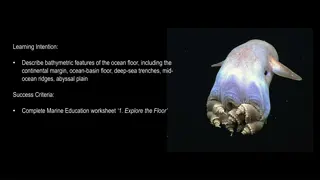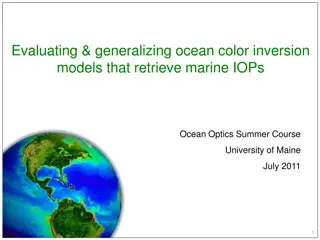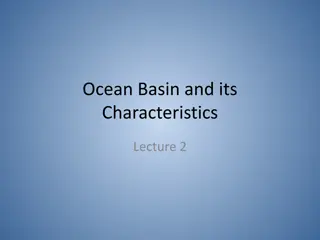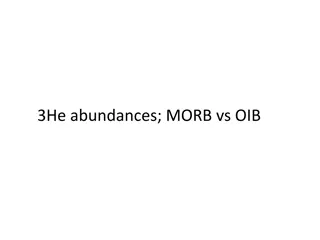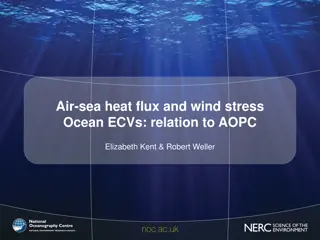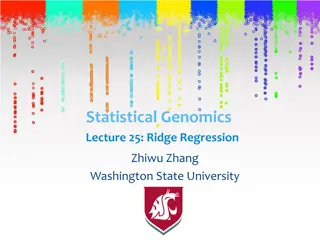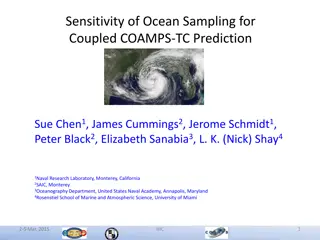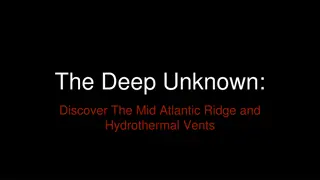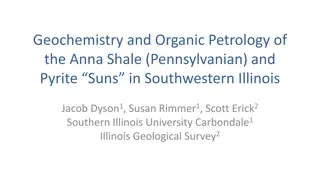Petrography of Mid-Ocean Ridge Basalts: Phenocryst Assemblages and Variability
The petrography of mid-ocean ridge basalts reveals insights into their magmatic evolution. Phenocryst assemblages, mineral crystallization sequences, and petrographic variability of MORB are discussed. Variations in magma compositions, cooling rates, and crystallization conditions are observed in basalts from normal and elevated ridge segments. The petrographic characteristics, mineral phases, and evolution of Mid-Ocean Ridge Basalts (MORB) are explored, shedding light on their formation processes.
Download Presentation

Please find below an Image/Link to download the presentation.
The content on the website is provided AS IS for your information and personal use only. It may not be sold, licensed, or shared on other websites without obtaining consent from the author.If you encounter any issues during the download, it is possible that the publisher has removed the file from their server.
You are allowed to download the files provided on this website for personal or commercial use, subject to the condition that they are used lawfully. All files are the property of their respective owners.
The content on the website is provided AS IS for your information and personal use only. It may not be sold, licensed, or shared on other websites without obtaining consent from the author.
E N D
Presentation Transcript
Kurdistan Region Iraq Ministry of Higher Education and Scientific Research Salahaddin University- Erbil College of Science Petrography of mid-ocean ridge basalts
Petrography of mid-ocean ridge basalts Both the chemical composition of the magma and its cooling history reflect the petrographic characteristics of MORB. Fabrics reflect the rapid cooling in a cold submarine environment of magmas extruded into near liquid temperature magmas. Grain sizes with 20-30 % phenocrysts are variable, from glassy to highly porphyritic types. Porphyritic basalts are common, and some highly phyric types are probably accumulative in origin.
The most commonly observed phenocryst assemblages are; olivine * Mg Cr spinel plagioclase + olivine * Mg Cr spinel plagioclase + olivine + augite Phenocrysts of Augite are rare and typically limited to rocks with abundant olivine and plagioclase. According to Bender et al. (1978), Walker et al. (1979), Bryan (1983), the first minerals to crystallize are olivine, spinel and calcic plagioclase, followed by augite and then Fe-Ti oxides Amphibole is highly rare and is observed only in alkaline-affinity basalts and in accumulated gabbros. A series of photomicrographs demonstrating the petrographic variability of MORB is shown in Figure 1. The phenocryst minerals appear deeply embedded in some instances and are distinctly out of equilibrium with the host magma. This confirms the importance of magma mixing in MORB's evolution.
Figure.1 Photomicrographs illustrating the petrographic variability of MORB: (a) olivine phyric MORB from the FAMOUS area of the Mid-Atlantic Ridge (x40, crossed polars); (b) coarse-grained plagioclase phyric MORB from the FAMOUS area (x40, crossed polars); (c) olivine-clinopyroxene phyric MORB from Reykjanes Ridge (MAR) (x40. crossed polars); (d) fine-grained MORB from the Reykjanes Ridge, showing quench crystals of plagioclase (x100, crossed polars).
Basalts from normal and elevated (hot spot) ridge segments have different petrographic features in general. In normal MORB, plagioclase is usually the dominant phenocryst phase, accompanied by olivine. Pyroxene is generally absent and bulk rock compositions may be modified by plagioclase and olivine accumulation. In contrast, MORB from elevated ridge segments include both olivine and pyroxene phyric types. This may reflect both differing magma compositions and crystallization conditions in the two environments (Michael & Chase 1987).
The composition of olivine phenocrysts varies with the host magma composition, ranging from Fo73 in ferrobasalts to Fo91 in picrites (Fig. 2). It is generally euhedral in habit, becoming more anhedral in pyroxene-rich rocks. Moderate zoning of the olivine phenocrysts is common and in many cases the cores are too Mg-rich to be in equilibrium with the bulk rock, attesting to their derivation from a more mafic magma by magma mixing. Mole % FeO/MgO in olivine Figure 2. Correlation of molecular FeO/MgO ratio in olivine and coexisting basalt glass for MORB from the FAMOUS area of the Mid-Atlantic Ridge (after Hekinian 1982, Fig. 1.15, p. 42).
A spinel phase (Mg chromite or Crspinel) is common in picritic and olivine-rich basalts, frequently occurring as tiny inclusions within olivine. This is rarely seen in plagioclase-rich basalts. Compositions of this spinel phase vary widely, with Al2O3 ranging from 12 to 30 wt. % and Cr2O3 from 25 to 45%. Extreme variations often occur within a single sample and are a consequence of the extreme sensitivity of the phase to FO2 fluctuations (Fisk & Bence 1979).
Plagioclase compositions range from An88 to An40 and are uniformly orthoclase poor. As with the olivine phenocrysts they are frequently not in equilibrium with the bulk rock, again attesting to the importance of magma mixing processes. In general, there is a negative correlation between the An content of early formed plagioclase and the spreading rate. The fast-spreading East Pacific Rise has plagioclase compositions in the range An56 88 whereas the slower-spreading Mid-Atlantic Ridge has more calcic plagioclase phenocrysts (An75 92) (Hekinian 1982). This reflects the fact that EPR basalts are more evolved than MAR basalts.
MORB clinopyroxene phenocrysts are colorless to pale green (in thin section) diopsidic augites, of generally very restricted chemical composition, clustering around Wo35-40 En50 Fs10-15 in the pyroxene quadrilateral (Fig. 3). Figure.3 MORB pyroxene compositions projected into the pyroxene quadrilateral (after Basaltic Volcanism Study Project 1981. Fig. 1.2 5.5, p. 137).
Gabbroic rocks dredged from the ocean floor show considerable overlap in composition with mid-ocean ridge basalts. Mineralogically, they comprise plagioclase, olivine, clinopyroxene, orthopyroxene and accessory minerals such as sphene, hornblende, apatite and titanomagnetite. Orthopyroxene-bearing gabbros are not common and are usually highly altered. However, their existence is significant as orthopyroxene is not observed as a phenocryst phase in the erupted basalts. Textures and modal proportions of the above minerals vary widely, as might be expected in rocks of an essentially accumulative origin.
